This project is the result of a collaborative effort between my colleagues Kexing He, Patricia Lavelle and myself.
The Task
The NYU Global Public Health program requires redesign of their Water Pollution and Sewage Treatment for students of Global Public Health lessons. The project shown here is intended to be one lesson out of a semester-long foundation course, covering the broad, high-level concepts students in this program might need in order to gain an introduction to the domain and make decisions about future courses and career pathways to explore. Below is the material provided to us for redesinging.
Overview (by Patricia)
The information we decided to include in this lesson is primarily factual and conceptual. As it is an introductory course, we expect students to have limited prior knowledge of water pollution issues and even less knowledge regarding wastewater treatment. Students may have an understanding of relevant systems in their homes and communities, but with so many varied possibilities, we felt it was better to assume no knowledge but also provide opportunities to reflect on any prior knowledge that might be there without requiring it. In reviewing Bloom’s Taxonomy (Krathwohl, 2002) we felt it was important for students to primarily remember and understand the information, and begin to evaluate related systems. We have decided on the following learning objectives as important goals for students to achieve in order to make the best use of this information:
- * Recognize the importance of sewage systems in a historical context
- * Identify the major sources of water pollution
- * Compare and assess/evaluate water treatment options
The Concept Map (by Kexing)
We have also decided to provide students with a concept map, as a form of pre-training. An advanced organizer, defined as introductory materials and ideational scaffolding by Ausubel (1968, p.148), is supposed to always be relative to the particular learners according to Mayer (1979, p.382). Mayer (1979) has also came up with a series of requirements and characteristics for them (p.382):
- 1. Always relative to the particular learners and subject matter
- Particular: our target learners are college students in Global Public Health major
- Subject matter: “Water Pollution and Sewage Treatment” is a pertinent topic to public health
- 2. Short set of verbal or visual information
- We have designed a concept map with short key words and visual icons related to water pollution and sewage treatment
- 3. Presented prior to learning a larger body of to-be-learned information
- This concept map is a form of pre-training and scaffolding, and presented to students prior to starting the lesson
- 4. Contains no specific content from the to-be-learned information
- We have only put short key words and avoided paragraphs from to-be-learned content
- 5. Provides a means of generating the logical relationships among the elements in the to-be-learned information
- Diagram: we chose to use the classic fishbone diagram, also known as a cause and effect diagram, to visualize the key potential causes of water pollution in order to discover the root causes
- The fishbone shape also implies a common result of water pollution: fish are killed due to biotoxins
- 6. Influences the learner's encoding processing, to provide a new general organization as an assimilative context that would not have normally been present, or to activate a general organization from the learner's existing knowledge that would not have normally been used to assimilate the new material
- The four sub-topics contain what students usually learn in high school chemistry and biology courses, but also go more in-depth into each section
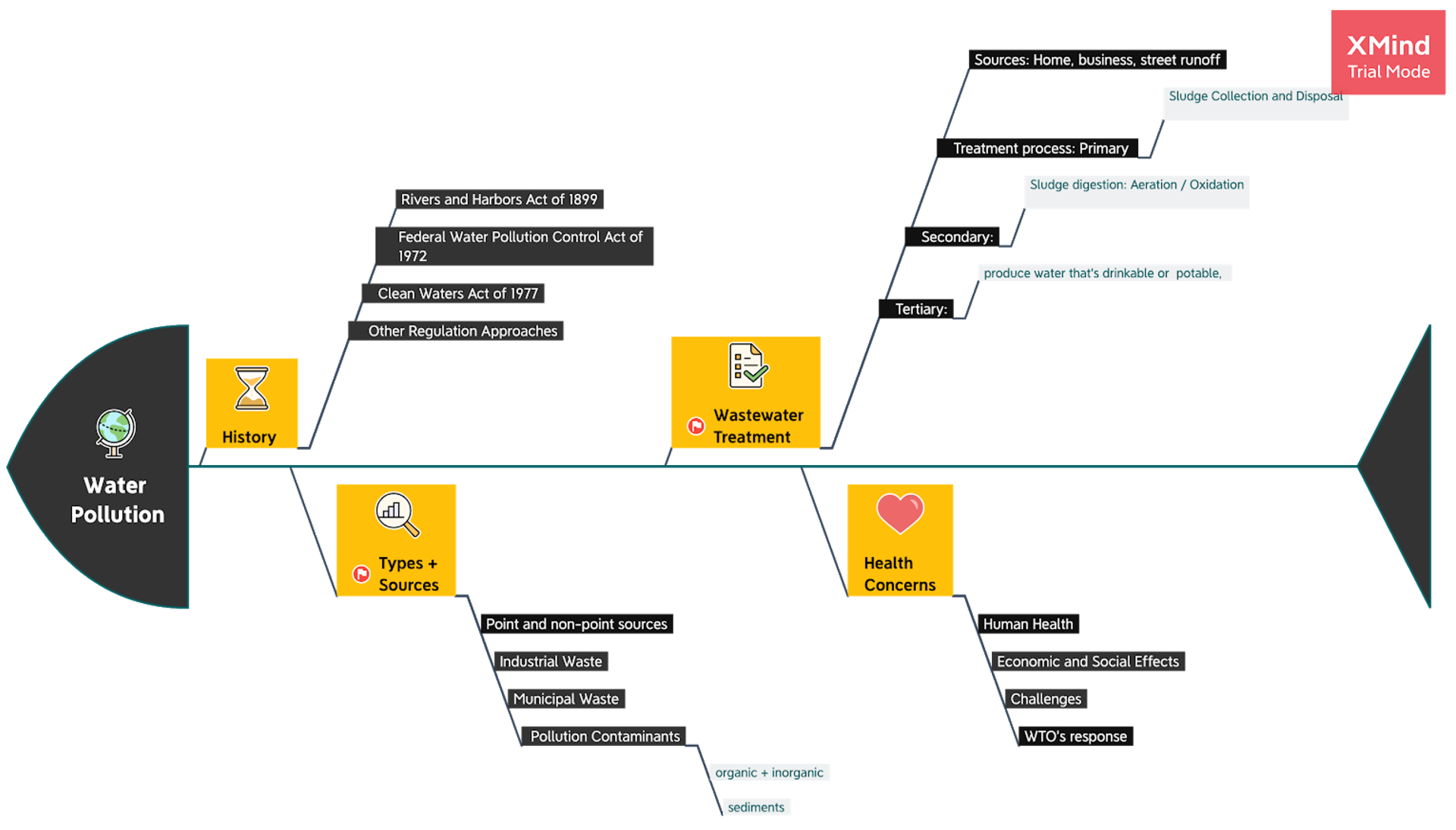
The Sample Lesson (by Ulises)
As this lesson is intended as part of an introductory course we do not assume the student has much knowledge prior to reviewing this content. The lesson would start and end with an assessment asking questions related to some of the information provided. The content would include simple questions such as identifying sources of pollution and the cycle of pollution and water treatment. The final assessment would start off with the same questions asked at the start as a way to measure learning. The student should be able to answer questions more accurately and perhaps more extensively to show that they have retained the factual information and understand the conceptual information. Additionally, the final assessment would include a reflective section, prompting the student to apply this knowledge to other contexts. One example would be asking the student to pull up a map of their town, and to identify sources of pollution and researching water storage and treatment facilities nearby.
A sample portion of the lesson can be found below. We have designed this lesson to be self-guided and the student would go at their own pace, with the full lesson taking 1-3 hours.
Design Principles for Multimedia Learning (by Patricia, Kexing and Ulises)
After the initial assessment, the student is presented with the main menu, which also serves as an advanced organizer. This menu breaks down the 4 main topics of the lesson along with key topics addressed.

Some slides contain reflective questions that can be incorporated into synchronous or asynchronous discussions. Slides also contain text boxes that allow students to respond while the question is on screen. These responses can be saved for the student to go back and review, and also be submitted to the instructor as another form of assessment.

Many of the slides are interactive, with the sub-topics housed under broader categories. Students are required to address each section before proceeding onward to the next topic.
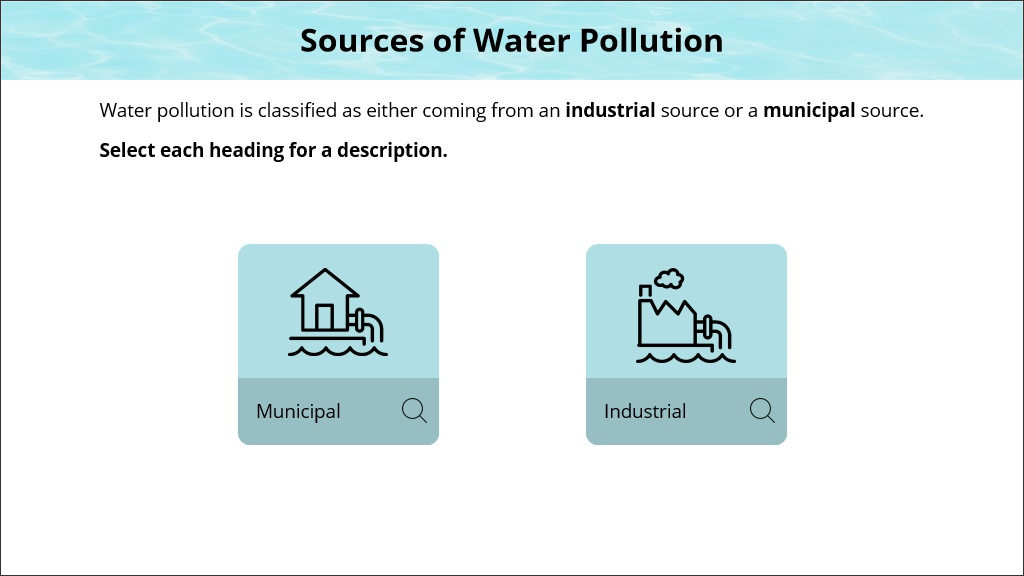
Some slides are activities that the student has to complete in order to demonstrate understanding of previously addressed topics. The image below shows an example of an exercise where students have to sort types of pollution and waste based on their source type. The student clicks and drags the waste into the corresponding section of the slide. The activity provides immediate feedback by not allowing the student to put the item in the wrong category.
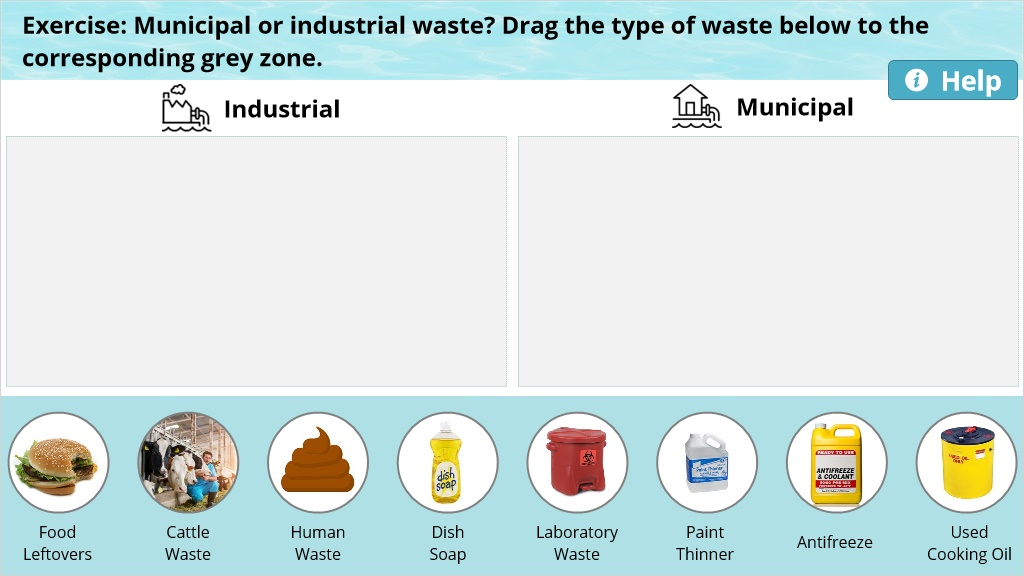
Once the activity is complete, an additional slide follows confirming the correct answers and providing additional context.
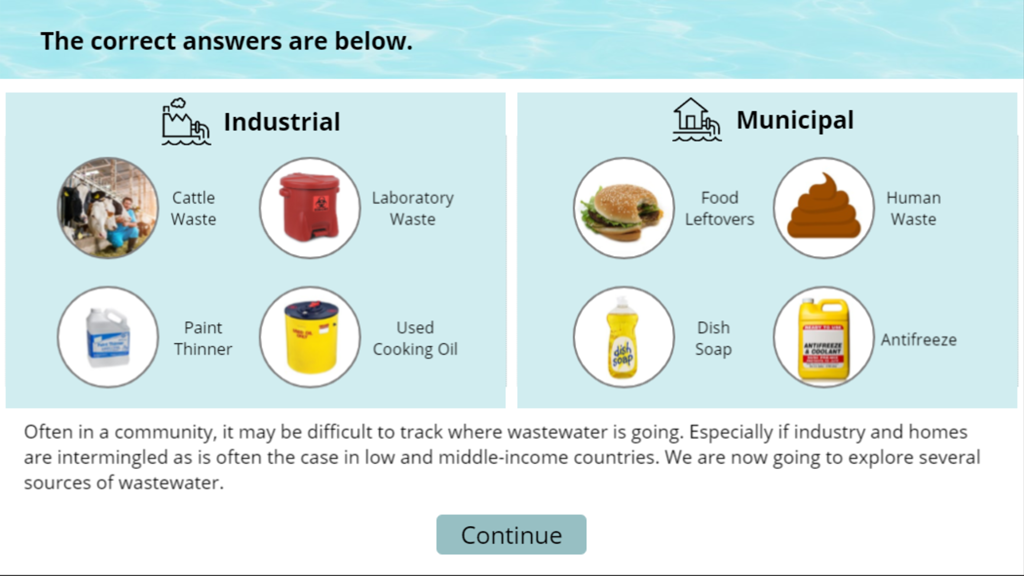
Some slides include static images with text, while others contain animations and videos as applicable to the content. These items are embedded into the slides so the student is not required to navigate away from the system.

The end of the unit brings the section overview as a review of what information was covered. It also provides a way for the student to navigate back to the main menu where they can review previous units or move on to the next section.
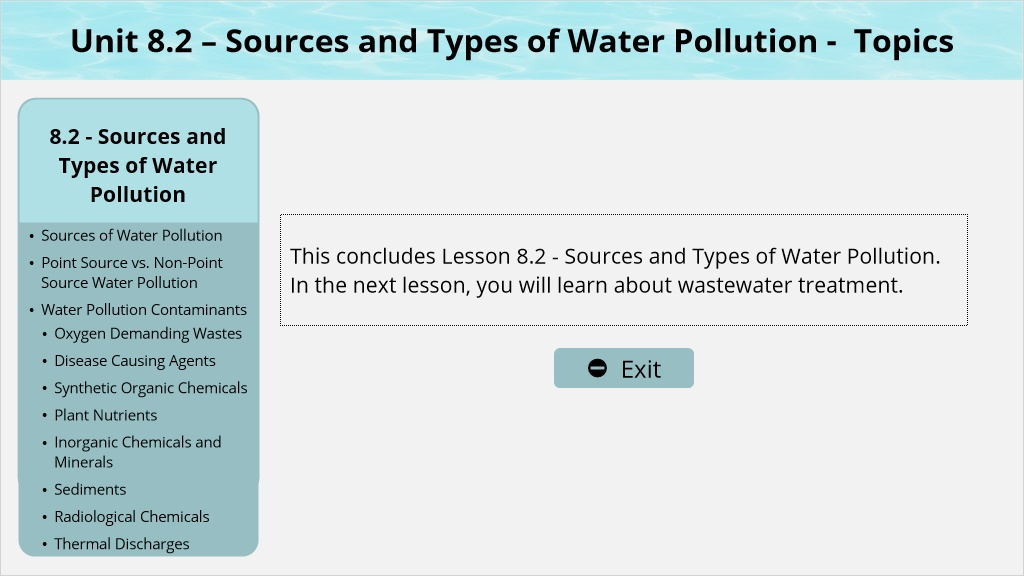
According to the Dual coding theory (Clark and Paivio, 1991) learners make more meaningful connections and build knowledge best when the information is presented in multiple formats. Our lesson plan engages the visual system in the form of images, animations, and videos. The auditory system is engaged via the embedded videos. While the verbal information is mostly provided in text format, this also relies on the auditory system for processing. The combination of both visual and verbal stimuli means the students will create a better mental representation of the concepts which leads to better encoding in long term memory.
Per cognitive load theory, our other focus is to reduce the extraneous load while managing the intrinsic load and maximizing the germane load. By managing all three parts of the cognitive load we reduce the chance of mentally overloading the student while helping the student focus only on the information they need to learn.
In order to reduce the extraneous load (Mayer and Fiorella, 2014), we’ve been intentional in the images used to ensure they relate to the material being presented, and have opted to not have any decorative imagery. Images included might be symbolic or iconic representations of concepts or photographic examples of the information. We have also eliminated music and sound effects to avoid distracting students. These reduce the extraneous load by allowing the student to focus on what information is essential.
We’ve adhered to the coherence principle by eliminating all extraneous material. We’ve also used signaling to help direct students to next steps, bolding the current unit in the menu, and using checkmarks on completed segments. We’ve also put certain text items in a bold font to help it stand out.

We’ve managed the redundancy principle by not including automatic narration of the text portions (and as this is self-guided a teacher would not be reading it aloud), but we have included optional closed captioning so students have the option to hear the text spoken, and to accommodate learners who might have difficulty reading the text (i.e. accessibility).
An example of spatial contiguity is how each icon is labeled, with the text in close proximity to the corresponding image.

We’ve also ensured that the video we’ve chosen to include provides narration over an animated sequence, which is an example of temporal contiguity.
We’ve managed the intrinsic load by providing the student with tools to manage essential processing. As we’ve assumed that students have limited or no prior knowledge our goal here is to present the information in a way that helps them make sense of it and form representations in their working memory. Our goal was to limit the information provided in the lesson as these are novice learners, and the questions and activities are meant to be simple. For students interested in going further they would take additional coursework with more complex information now that they have this basic knowledge.
We’ve started with the segmenting principle by breaking down the lesson into 4 overall units, which allows learners to pace themselves as needed, using the Previous and Next buttons. Additionally the units are broken down into additional sub-topics that assists students with chunking the information as it's being processed. Following the pre-training principle we’ve provided students with an advance organizer, built into the lesson, that follows the way we’ve segmented the material. It’s built into the menu so the student returns to it at the start/end of each unit in the lesson. Additionally we’ve provided students with a concept map (also tied to the way the information has been segmented) to help visualize the relationship between factual/conceptual information being presented. Following the modality principle, we’ve used videos that provide narration and do not include duplicative text. While we have a lot of text on non-video slides, the optional narration allows for the cognitive load to be decreased.
Lastly we’ve maximized the germane load in order to help students begin to make sense of the information and support schema construction. Per the multimedia principle, we’ve incorporated a variety of graphic types, including ones that are representational (such as photos), organizational (concept map), and transformational (animations and videos). We’ve also provided the information in both text and audio formats. In accordance with the personalization principle, the text and audio provided are conversational and casual to the extent possible. Additionally, the audio is done in a human voice instead of a robotic one and with no speaker pictured, choosing instead to display related visuals (per the personalization, voice, and image principles).
There are some additional principles we’ve kept in mind when designing this lesson. It is intended as a guided activity, with the navigation allowing for a flow between topics while allowing students to go back and review topics as needed. We’ve incorporated feedback into the activity designed. There is both immediate feedback provided when placing items into incorrect categories and it’s followed up with additional feedback on the correct responses. We’ve also included reflection questions that prompt the student to consider what they’ve learned throughout the lesson. These questions can also be used for an instructor to provide feedback if responses are submitted, but can also be referred to as part of a synchronous discussion.
We’ve tried to respect and account for the individual differences of each student by providing as much variety as possible. Allowing for self-pacing, presenting information in audio and visual formats, and providing multiple ways to engage with the lesson (and ways to incorporate it into a more social format with in-person scaffolding) allows us to meet the needs of many students at once.
References
- Ausubel, D. P. The Psychology of Meaningful Verbal Learning. New York: Gruene and Stratton, 1963
- Butcher, K. (2014). The Multimedia Principle. In R. Mayer (Ed.), The Cambridge Handbook of Multimedia Learning (Cambridge Handbooks in Psychology, pp. 174-205). Cambridge: Cambridge University Press. doi:10.1017/CBO9781139547369.010
- Clark, J., & Paivio, A. (1991). Dual Coding Theory and Education. Educational Psychology Review, 3(3), 149-210.
- Clark, R. C., & Mayer, R. E. (Eds.). (2016). Engagement in e-learning. In e-Learning and the Science of Instruction (pp. 219–235). Hoboken, NJ: John Wiley & Sons.
- Krathwohl, D. R. (2002). A revision of Bloom’s taxonomy: An overview. Theory into Practice, 41(4), 212–218.
- Mayer, R.E. (1979). Can Advance Organizers Influence Meaningful Learning? Review of Educational Research, Vol. 49, No. 2 (Spring, 1979), pp. 371-383. American Educational Research Association.
- Mayer, R. E. (2014). Cognitive theory of multimedia learning. In R. Mayer (Ed.), The Cambridge Handbook of Multimedia Learning (2nd ed., pp. 43–71). Cambridge: Cambridge University Press.
- Mayer, R. E., & Fiorella, L. (2014). Principles for reducing extraneous processing in multimedia learning: Coherence, signaling, redundancy, spatial contiguity, and temporal contiguity principles. In R. Mayer (Ed.), The Cambridge Handbook of Multimedia Learning (2nd ed., pp. 279–315). Cambridge: Cambridge University Press.
- Mayer, R.E., Fennell, S., Farmer, L., & Campbell, J. (2004). A personalization effect in multimedia learning: Students learn better when words are in conversational style rather than formal style. Journal of Educational Psychology, 96, 389–395
- Mayer, R. E., Mathias, A., & Wetzell, K. (2002). Fostering understanding of multi-media messages through pre-training: Evidence for a two-stage theory of mental model construction. Journal of Experimental Psychology: Applied, 8, 147–154.
- Mayer, R. E., & Pilegard, C. (2014). Principles for managing essential processing in multimedia learning: Segmenting, pre-training, and modality principles. In R. Mayer (Ed.), The Cambridge Handbook of Multimedia Learning (2nd ed., pp. 316–344). Cambridge: Cambridge University Press.
- Moreno, R., & Mayer, R. E. (2010). Techniques that increase generative processing in multimedia learning: Open questions for cognitive load research. In J. L. Plass, R. Moreno, & R. Brunken (Eds.), Cognitive Load Theory (pp. 153–178). Cambridge: Cambridge University Press.
- Paivio, A. (1986). Mental representations. New York: Oxford University Press.

